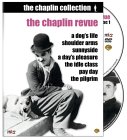| Reviews & Columns |
|
Reviews DVD TV on DVD Blu-ray 4K UHD International DVDs In Theaters Reviews by Studio Video Games Features Collector Series DVDs Easter Egg Database Interviews DVD Talk Radio Feature Articles Columns Anime Talk DVD Savant Horror DVDs The M.O.D. Squad Art House HD Talk Silent DVD
|
DVD Talk Forum |
|
|
| Resources |
|
DVD Price Search Customer Service #'s RCE Info Links |
|
Columns
|
|
|
Chaplin Revue (2 Disc Special Edition), The
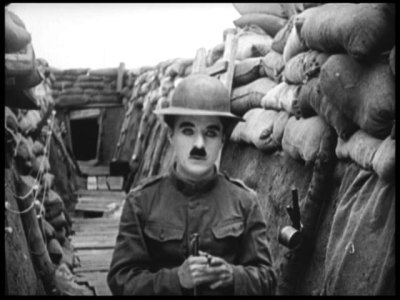 In 1917 Chaplin signed an incredibly lucrative contract with First National Picture Corporation that would make him an independent contractor. Chaplin agreed to make eight two-reel comedies over the next eighteen months. He would receive $125,000 for each picture, but he had to pay for all cost of producing the movies. He would then split the profits from the distribution of the pictures 50/50. In addition to this he was giving a $75,000 signing bonus. The biggest part of the contract though was that he would retain the copyright on his films, and in five years he would also own the worldwide distribution rights.
In 1917 Chaplin signed an incredibly lucrative contract with First National Picture Corporation that would make him an independent contractor. Chaplin agreed to make eight two-reel comedies over the next eighteen months. He would receive $125,000 for each picture, but he had to pay for all cost of producing the movies. He would then split the profits from the distribution of the pictures 50/50. In addition to this he was giving a $75,000 signing bonus. The biggest part of the contract though was that he would retain the copyright on his films, and in five years he would also own the worldwide distribution rights. Back then it wasn't clear if owning older movies and being able to distribute them would be a big source of money. At the time most films were only in circulation as long as the prints held up, usually about ninety days. After this it wasn't worth the money to strike new prints and the films were discarded. But Chaplin, and his brother Syd who negotiated the deal, thought that there might be demand for Chaplin film in the future. They were right.
For Charlie though, the most advantageous part of the contract was that he would no longer have executives breathing down his neck. If he wanted to film many takes of a scene and use the best one, he was free to. After all, he was paying for the film. He also had a huge amount of time to make his pictures. A year and a half for eight two-reelers was astounding. Keystone could produce that in a couple of months.
Why was First National willing to give Chaplin such a lucrative deal? Primarily because they were sure that they'd make money. Chaplin was very, very popular. His popularity spawned scores of Chaplin imitators (including Harold Lloyd) making similar films and touring the vaudeville houses. There were songs about him and even Chaplin look-a-like competitions. (Chaplin himself entered one on the sly and didn't make it to the finals.) His films were in such demand that they were demanding higher rental fees than most feature length films of the time. First National was confident that they could make at least $125,000 per film.
The other reason they were willing to pay such high rates was because they were a new outfit that wanted credibility. At the time there were two major theater chains, Lowe's and Paramount. Those two giants were squeezing independent theater owners out of the picture. First National was created to distribute movies to the independent movie houses and they wanted to be able to offer their clients something that would entice them to sign up.
This was more important than it may sound. Back in the early day of film, there was the practice of block booking. If you wanted a movie put out by a certain studio, you had to take the studio's entire output, good and bad. The theaters hated it because it forced them to book lousy pictures, but all the distributors practiced this, so there was no alternative. With First National being able to offer Chaplin films, it would be easy sell the rest of their product too.
Armed with a very beneficial Charlie Chaplin built himself a film studio, and got to work. The eight movies he made for First National would include some masterpieces, and it was during this time that he hit upon the formula that would propel him to even greater success.
In 1959 Chaplin revisited the work he had done for First National. Shorts were no longer being shown in theaters, so he strung together his three best shorts from this period, in slightly edited form, added an introduction (taken from his unreleased How to Make Movies promotional film) and some narration to create a feature length compilation that was then released.
M2K has remastered the video to this movie and released as a two DVD set. The first DVD contains The Chaplin Revue, which contains three shorts: A Dog's Life, Solider Arms, and The Pilgrim. The second DVD has his other First National shorts, A Day's Pleasure, Sunnyside, The Idle Class, and Pay Day. (The Kid, his first feature film that was made for First National, is available on a separate DVD.)
The Shorts:
The Chaplin Revue consists of:
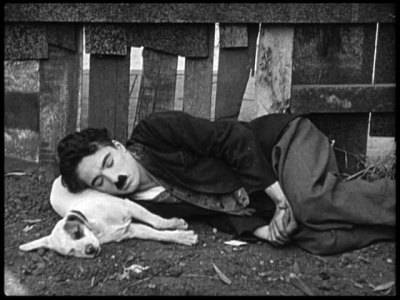 A Dog's Life: This was Chaplin's first movie under his new contract, and you can see that the freedom he had, both creatively and with scheduling, let him produce a magnificent movie.
A Dog's Life: This was Chaplin's first movie under his new contract, and you can see that the freedom he had, both creatively and with scheduling, let him produce a magnificent movie.
The tramp finds a dog. Since they are both homeless, they have something in common and become inseparable friends. The Tramp even goes as far as to hide the dog in his pants so he can sneak is pal into a bar. Here he meets a singer (Edna Purviance) and is smitten. But the bartender soon finds out that the homeless vagabond has no money, and kicks him out. Meanwhile, two muggers attack a drunken rich man. The steal his wallet and bury it in an empty lot when the police start chasing them to hide the evidence.
As luck would have it, the tramp happens to sleep in the empty lot that night, and while he's snoozing, his dog digs up the money filled wallet. It contains enough money for he and the girl to run away and start a new life together, but when the muggers find out he has the wallet, it won't be easy for the small fellow to keep it.
Many Chaplin fans consider this his first masterpiece, and it is easy to see why. There is a great economy in the film, every gag is funny, and advances the plot at least a little. In this film Chaplin, possibly by accident, stumbles upon one of the aspects of comedy that he will develop further in the future with great success. The movie is his first real intimate picture where Chaplin is able to make the viewer identify with the characters and care about their future. You find yourself not only laughing with the Tramp, but also rooting for him. You want him to succeed in his quest to obtain the wallet, and by extension happiness. But there is no aspect of melodrama to the picture. He makes you care about the people through comedy, something that hadn't been done before. The only thing missing from this short that his other masterpieces would have is a strong sentimental facet. He would add that aspect a little later in his first feature, The Kid, a movie that is very similar to this short.
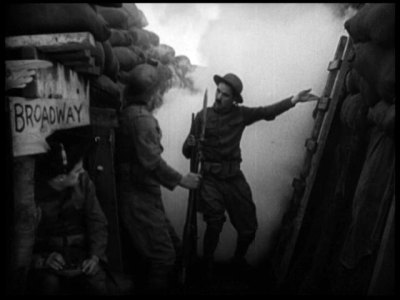 Shoulder Arms: His second film for National was released just weeks before the armistice ending WWI was signed. There was a lot of debate whether or not the trenches of France was an appropriate setting for a comedy. Chaplin was sure it was, and the huge box office proved him right.
Shoulder Arms: His second film for National was released just weeks before the armistice ending WWI was signed. There was a lot of debate whether or not the trenches of France was an appropriate setting for a comedy. Chaplin was sure it was, and the huge box office proved him right.
The Tramp is in the army, but he is not a very good solider. He can't hold a rifle properly, and messes up all of the drills that his CO puts him though. He's finally sent to bed to rest for the attack to come. The next morning, the little fellow is sent over the top. There is a great sequence where he is energized to charge the enemy, until he sees other people being killed as soon as they get onto the battlefield. Chaplin starts up the ladder, but being a gentleman, he climbs back down and hold out his arm in an 'after you' gesture.
Later, not realizing what he is doing, Chaplin volunteers for a dangerous mission into enemy territory. Here he meets Edna Purviance, a French peasant girl who hates the Germans. They have been cruel to her, and she'd like to get away from them. But Charlie must save an allied spy who has just been captured before he can take her to safety.
This is another fantastic film. Chaplin is able to create a very funny piece without belittling the horrors of war, a very impressive feat. The movie shows the trenches as being dirty and wet, and he doesn't flinch from the danger, but it is not a morose film, on the contrary, it is very funny. The scene where he is camouflaged as a tree is astounding. After the Germans discover his costume, they chase him. Of course he runs into a forest. Chaplin is positioned clearly in the frame, but you can't see him until he bonks the German solider on the head. Not only is he hiding from the enemy, but the viewer too. Not as intimate as A Dog's Life, but it is just as funny.
The Pilgrim: Chaplin is an escaped convict who manages to steal the clothes of a minister who is bathing in a stream. Dressed in these purloined garments, the tramp gets off a train and is mistaken for a rural community's new pastor. Trapped into giving an impromptu sermon, Charlie has a change of heart during his speech, and renounces his immoral ways. He settles in, taking a room with an attractive girl's family.
Although Charlie is on the straight and narrow, he is still a wanted man. A friend from jail shows up and decides that the family Charlie is staying with would be easy pickings. He works his way into the household, and steals the money they were saving to pay off the mortgage. Charlie feels responsible, and vows to get the money back, but it may be too late. The sheriff shows up with a wanted poster that has Charlie's face on it.
This was the last film that Chaplin made to fulfill his contract with First National. A four-reeler, National agreed to count it as the final two films that Chaplin owed them. Though by this time Charlie was finished with the format of short comedies, this movie doesn't have the rushed feel that some of his earlier films, such as A Day's Pleasure, had. This movie contains all the ingredients that he had been working with during this stage of his career: it is funny, but still warm and sweet. He doesn't tug at the heartstrings like he did in The Kid, but that seemed more like a conscience decision. By this time Chaplin is confident that he can convey the emotions that a movie calls for. Unlike Sunnyside, where he was trying too hard, you feel for the convict, and see his dilemma clearly.
A funny film, this would be the last short that Charlie Chaplin ever made.
Disc Two:
For some reason, these shorts are not presented in chronological order. I will list them in the order they were originally released.
One irritating aspect to this DVD is that after each short ends there are two full minutes of copyright protection warnings in various languages. These are unskippable, and you have to sit through them before you can see the next short. You might want to hit the 'menu' button on your remote just as the short ends to avoid this.
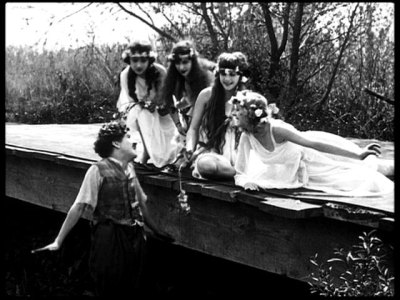 Sunnyside: After the great success of his first two films for First National, Charlie felt emboldened to experiment even more. In this third National film, Charlie can be seen toying with emotion and tone. Unfortunately, he is not successful this time.
Sunnyside: After the great success of his first two films for First National, Charlie felt emboldened to experiment even more. In this third National film, Charlie can be seen toying with emotion and tone. Unfortunately, he is not successful this time.
Chaplin is a laborer at a seedy rural hotel. His boss wakes him up at 4 am every morning by kicking him repeatedly, before returning to bed himself. Chaplin has a lot of duties at the hotel, making breakfast, taking the cows out to pasture, and mowing the grass in the lobby, but what really occupies his thoughts is his girlfriend (Edna Purviance.) One day a dandy from town crashes his car outside of the hotel. After he recovers, the snappy dressed city slicker takes a fancy to Edna, and sets out to woo her. Can the run down tramp be any match for the charms of a sophisticated society man?
This was an experiment that didn't work. Chaplin is trying to elicit sympathy and make us feel the tramp's heartbreak with this film, but he doesn't succeed. The tramp in this picture is too pathetic. He doesn't fight back, like he did in A Dog's Life, but just takes what is offered to him. He never even attempts to even the score with his mean and overbearing boss. When he notices that dandy flirting with Edna, he merely walks away. This fatal acceptance doesn't make the tramp sympathetic, just pathetic.
The humor in this movie is off too. The scene where he mows the lobby is funny, but most of the other gags just miss. There is a very nice dance scene, where the tramp is knocked out and dreams that fairies come and frolic with him, but it isn't particularly funny.
The public didn't like this picture either; it didn't do nearly as well as his other films. It is still an interesting chapter in Chaplin's evolution though. You can see that he is attempting to add an emotional aspect to his pictures, while keeping them small and intimate. Though it didn't work with this project, he would go on to successfully integrate these characteristics into his films in the near future.
A Day's Pleasure: In his 4th National film, Charlie takes his family out for a drive and a boat ride. He has trouble starting the car, gets seasick on the boat, and runs into trouble with the police on his way home.
After the failure of Sunnyside, his previous film, Chaplin decided to play it safe. This short was a throwback to Chaplin's days at Keystone. This wasn't the tightly plotted comedy like A Dog's Life, but just a series of gags that were thrown together. It was mildly amusing, but only as entertaining as your run of the mill Sennet comedy. It looks like Chaplin had trouble coming up with gags for this one. At one point he has trouble assembling a folded deck chair. He tries to unfold it in several ways, and then throws it over the side. The end was funny, but his trouble with the chair wasn't entertaining at all, it just didn't work. The same can be said of the gag with car at the beginning. Charlie can start his car, but whenever he goes to get in, the car stops. Not a bad setup, but there is no payoff at the end. After a while he simply runs into the driver's seat and drives off. There was no inventive way of 'fooling' the car, or humorous punch line. He just drives off.
This short did have its moments. The scene with Chaplin being stuck in the tar at the end was funny, and so was the fight on the boat, but overall, this is one of his lesser works.
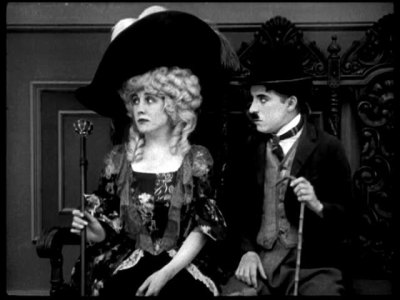 The Idle Class: After his huge success with The Kid, Chaplin made a couple of shorts that were funny but didn't have the emotional content that his more ambitious projects contained. The first of these was The Idle Class in which Chaplin plays a dual role as both a rich drunken socialite, and as the tramp.
The Idle Class: After his huge success with The Kid, Chaplin made a couple of shorts that were funny but didn't have the emotional content that his more ambitious projects contained. The first of these was The Idle Class in which Chaplin plays a dual role as both a rich drunken socialite, and as the tramp.
At a summer retreat, a rich, absent-minded man (Chaplin) is running late to pick up his wife (Edna Purviance) from the train station. After carefully primping himself, he runs out into the hotel lobby only to find out that he has forgotten his pants. Hiding in a telephone booth, he manages to make it back to his room without being scene just as his wife walks in. Quickly, he jumps into bed (heaven forbid a wife see her husband in underwear!) still wearing his hat and coat. Seeing him like that, the wife assumes he's drunk again and moves into a different set of rooms.
Meanwhile, the tramp arrives on the same train, but riding under it rather than inside it. He's come to play some golf, and has brought his clubs, but he doesn't have a ball. There an amusing set of scenes where he conspires to obtain a ball to play with, and while he is at it spies Edna. He immediately falls for her.
That evening, there is a costume party at the hotel, which the tramp manages to crash. Edna sees him and assumes that he is her husband, who is at the party, but dressed as a knight in armor whose faceplate is sealed shut. This comic case of mistaken identity leads to some great moments when the real husband sees the tramp flirting with his wife.
Though this movie is in many ways a throw back to his earlier films, it is still funny. The look on the tramp's face when the debonair Edna asks him to sit with her is priceless. This film, and the next, reminds us that Chaplin could do straight comedy, as well as the more sentimental films that he is famous for.
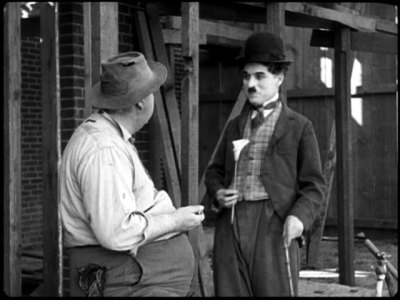 Pay Day: This is another comedy that is not emotional, but very funny.
Pay Day: This is another comedy that is not emotional, but very funny.
Charlie is a worker at on a construction sight. He arrives late, but gets to work piling bricks and digging holes. At the end of the day, he gets paid, and spends the night drinking with his mates down at a bar.
This simple film is one of the funniest that Chaplin made for First National. It is more absurd than the others that he made at this time. Instead of embracing the intimate formula that served him so successfully in A Dog's Life and The Kid, he's going in the opposite direction with this movie, going more for laughs than realism. This is one of the few films where Chaplin uses trick photography. While working up high, a fellow worker tosses up some bricks for Chaplin to stack. He catches them in his hands, on the back of his feet, and with his elbows. Having Chaplin drop the bricks, and then running the film backwards accomplished this great scene. It was a simple trick, but one that has great comic effect.
Taken together, this set of shorts shows Chaplin's technique maturing as he searches for a style and voice to tell his stories. The First National shorts are an important stage in Chaplin's evolution as a comic, and belong in every silent movie collection.
The DVD:
This movie was mastered from a PAL video source and converted to NTSC. What does that mean? Without going into the details, it means that the film runs 4% faster than it should. The pitch seems to have been corrected on the soundtrack, but the playing times are still 4% shorter than they should be. This is very unfortunate, but not a huge deal. About the only way to notice the difference is to check the run times, the slight speed up is not noticeable to the casual viewer. Even someone familiar with the movie would be very hard pressed to see the difference, it is very slight. Another reason that this in a non-issue is that silent movies did not have a standard film rate. It wasn't until sound movies arrived that projection speeds were standardized. (That's why silent movies are always measured in reels of film and not the length of time it took to show them.) Sometimes the distributor would even send notes with the films instructing the projectionist to run certain scenes faster or slower. So the fact that these are 4% faster than an arbitrary 'silent speed' should not be a large factor when deciding whether or not to purchase this set.
Audio: The orchestral score, written by Chaplin, is available in a stereo and 5.1 mix. The audio quality was very clear and clean with no noticeable hiss or distortion. The 5.1 mix had a fuller, more encompassing sound than the stereo track, but both were sufficient. There are subtitles in French, Spanish, Portuguese, Chinese, Thai, and Korean.
Video: The restored full frame video for this movie was excellent. The image was clean with an excellent amount of detail. The contrast is very good with the blacks being solid and a good range of gray tones. A stunning looking disc.
The Extras:
DVD One:
Introduction by David Robinson (5 min): The Chaplin biographer gives a short overview of Chaplin's life during the time he was with First National.
Deleted Scenes from Soldier Arms (10 minutes): A series of scenes that Chaplin deleted when he compiled The Chaplin Revue.
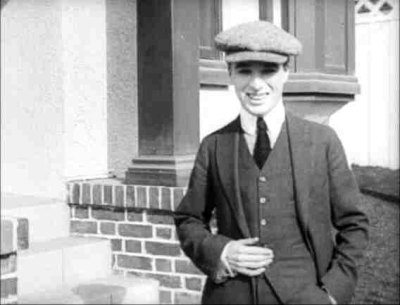 How to Make a Movie (16 minutes): (This extra also appears on the The Kid DVD.) This 1918 short is a delightful bonus! I had heard about this for years, but had never seen it. A promotional short Chaplin made to show First National when he signed with them. It was never released theatrically. A genie grants Chaplin a wish, and with time-lapse photography, his studio is magically raised. There are a lot of behind-the-scenes type shot, mostly set up, that show what it was like making movies in the late teens. There is an interesting but brief sequence where they show how movie film was developed and processed. The end has a sequence where Charlie puts on his Tramp outfit and goes to play golf. It includes some amusing gags. I'm very happy they included this historical piece on this disc.
How to Make a Movie (16 minutes): (This extra also appears on the The Kid DVD.) This 1918 short is a delightful bonus! I had heard about this for years, but had never seen it. A promotional short Chaplin made to show First National when he signed with them. It was never released theatrically. A genie grants Chaplin a wish, and with time-lapse photography, his studio is magically raised. There are a lot of behind-the-scenes type shot, mostly set up, that show what it was like making movies in the late teens. There is an interesting but brief sequence where they show how movie film was developed and processed. The end has a sequence where Charlie puts on his Tramp outfit and goes to play golf. It includes some amusing gags. I'm very happy they included this historical piece on this disc.
The Bond (1918) (10 min): An amusing propaganda short that Chaplin made to support the War effort. A series of skits that show how important different types of bonds are, especially war bonds.
Photo Gallery: Some production stills from the movie.
Movie Posters: A selection of movie posters advertising these movies.
The Chaplin Revue Trailer (2 min)
DVD Two:
Introduction by David Robinson (5 min): More commentary by David Robinson. A nice introduction to these films.
Deleted Scenes from Sunnyside (9 min): A series of scenes that Chaplin deleted when he reworked the film near the end of his life.
The Visitors (7 min): Some behind-the-scenes footage at Chaplin's studio taken while these shorts were made.
Harry Lauder (8 min): An uncompleted short that Chaplin was making with British music-hall comedian Harry Lauder for war relief.
Photo Gallery: Some production stills from the movie.
Movie Posters: A selection of movie posters advertising these movies.
Chaplin Collection (12 min): A selection of scenes from each of the movies in the Chaplin Collection.
Final Thoughts:
This set is a wonderful chance to see Chaplin blossom as a comedian. It has some great movies, especially the three that comprise The Chaplin Revue. The picture is stunning; you won't see these shorts ever look any better. Highly Reccomended.
|
| Popular Reviews |
| Sponsored Links |
|
|
| Sponsored Links |
|
|
| Release List | Reviews | Shop | Newsletter | Forum | DVD Giveaways | Blu-Ray | Advertise |
|
Copyright 2024 DVDTalk.com All Rights Reserved. Legal Info, Privacy Policy, Terms of Use,
Manage Preferences,
Your Privacy Choices | |||||||









